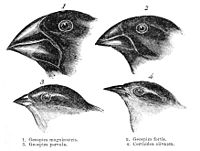
Photo from wikipedia
Life history events, from mating and voltinism to migration and emergence, are governed by external and historically predictable environmental factors. The ways humans have altered natural environments during the Anthropocene… Click to show full abstract
Life history events, from mating and voltinism to migration and emergence, are governed by external and historically predictable environmental factors. The ways humans have altered natural environments during the Anthropocene have created myriad and compounding changes to these historically predictable environmental cues. Over the past few decades, there has been an increased interest in the control temperature exerts on life history events as concern over climate change has increased. However, temperature is not the only life history cue that humans have altered. In stream ecosystems, flow and light serve as important life history cues in addition to temperature. The timing and magnitude of peak flows can trigger migrations, decreases in stream temperature may cause a stream insect to enter diapause, and photoperiod appears to prompt spawning in some species of fish. Two or more of these cues may interact with one another in complex and sometimes unpredictable ways. Large dams and increasing impervious cover in urban ecosystems have modified flows and altered the timing of spawning and migration in fish. Precipitation draining hot impervious surfaces increases stream temperature and adds variability to the general pattern of stream warming from climate change. The addition of artificial light in urban and suburban areas is bright enough to eliminate or dampen the photoperiod signal and has resulted in caddisfly emergence becoming acyclical. The resulting changes in the timing of life history events also have the potential to influence the evolutionary trajectory of an organism and its interactions with other species. This paper offers a review and conceptual framework for future research into how flow, temperature, and light interact to drive life history events of stream organisms and how humans have changed these cues. We then present some of the potential evolutionary and ecological consequences of altered life history events, and conclude by highlighting what we perceive to be the most pressing research needs.
Journal Title: Integrative and comparative biology
Year Published: 2021
Link to full text (if available)
Share on Social Media: Sign Up to like & get
recommendations!